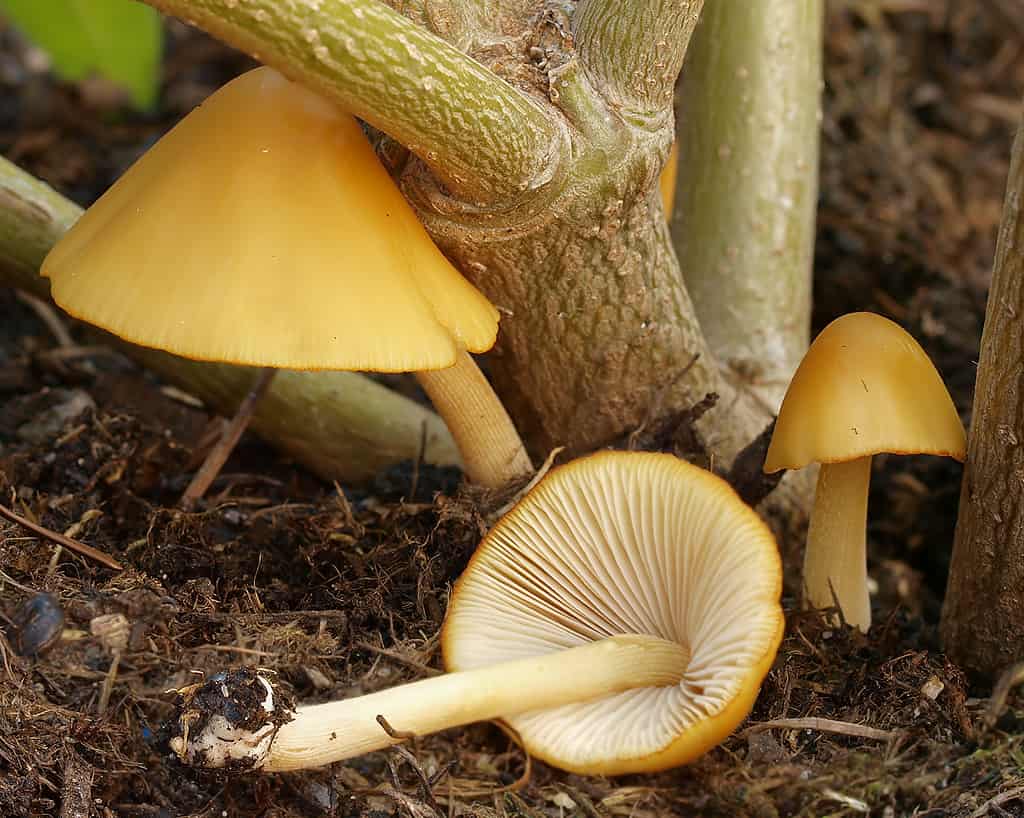If you enjoy caring for houseplants, you might be a bit alarmed to discover mushrooms sprouting from the soil. After all, are the mushrooms poisonous? Will they harm your plants? Should you remove them?
The answer to these questions depends on the species of the mushrooms and the growing requirements of your houseplant. Typically, mushrooms fruiting alongside houseplants indicates an abundance of moisture in the soil and humidity in the environment. If your plant is happy in this environment and the fungus is not a plant pathogen, then the mushroom is likely not causing any harm to your plant. In fact, by breaking down organic matter in the potting soil, the fungus can help the plant roots uptake more nutrients. However, plants that require well-drained soil and low to moderate humidity may not fare well in an environment in which mushrooms are fruiting.
Finally, some mushrooms that may be neutral or beneficial to your houseplants are poisonous to pets or people. In these instances, you may need to move the pot out of reach of young children and pets. Or you can remove the mushrooms as they fruit if you would like.
In this guide, we’ll cover three commonly described types of mushrooms growing with houseplants and what they mean for the health of your plants and household.
1. Mushrooms in Your Houseplants: Flowerpot Parasol (Leucocoprinus birnbaumii)

One of the most common mushrooms found in store-bought
houseplant soil
is the flowerpot parasol (
Leucocoprinus birnbaumii).
©DAN559/Shutterstock.com
If you’ve noticed a cluster of yellow, scaly-capped mushrooms growing from your houseplant soil, the species is likely the flowerpot parasol (Leucocoprinus birnbaumii). This saprobic fungus thrives off the organic matter found in nutrient-rich potting soil, especially orchid potting mixtures. Saprobic fungi obtain nutrients by decomposing organic matter. This fungus won’t hurt your plants and simply indicates a moist soil rich in organic matter suitable for this species to decompose. However, if your plant needs soil with really good drainage and little moisture, the presence of this mushroom may indicate overwatering.
When young, the flowerpot parasol features conical, tightly closed caps. As the mushroom matures, the cap expands, becoming broadly convex to bell-shaped, often with a prominent bump in the center of the cap. Leucocoprinus birnbaumii can cause slight GI distress for a small percentage of people and some pets if a lot of the mushrooms are consumed. If you can place the pot out of reach of young children and pets, we recommend allowing these benign mushrooms to cohabitate with your plants. By decomposing organic matter in the soil, the fungus is contributing to nutrient availability for your plant. However, If you think removal of the mushrooms is necessary, you’ll need to completely replace the soil that your plant is growing in, as they will keep coming back if not.
2. Golden Conecap (Conocybe aurea)

The golden cone cap (
Conocybe aurea) commonly grows in potting mixes rich in compost and nitrates.
A saprophyte preferring to grow in nitrogen and compost-rich substrates, the golden conecap (Conocybe aurea) can thrive alongside houseplants. This fragile mushroom fruits in warm weather, and it commonly appears in greenhouses in the spring.
At immaturity, the caps are conical to tightly bell-shaped. As the cap expands, it becomes broadly bell-shaped to almost flat. The cap is typically ochre with finely striated margins. The center of the cap is tawny ochre. When young, the gills are pale tan, but they darken to tan-brown when the spores mature. The spore print is rusty-orange brown. The toxicity of Conocybe aurea is unknown. However, it is closely related to other species in the Conocybe genus known to be seriously poisonous.
3. Mushrooms in Your Houseplants: Bird’s Nest Fungi (Nidulariaceae)

Bird’s nest fungi (
Nidulariaceae) are whimsical, harmless mushrooms you may find growing alongside your houseplants, especially succulents.
©Henri Koskinen/Shutterstock.com
In the fall, you may discover growing alongside your shade-loving houseplants a cluster of tiny mushrooms masquerading as minute birds’ nests complete with eggs. About 60 species of bird’s nest fungi belong to any of five genera of the Nidulariaceae family. They fruit from rotted wood, mulch, bark chips, compost, and humus-rich soil.
These charismatic little mushrooms create an impressive illusion of tiny birds’ nests. The brown, tan, white, or grey nest-shaped fruiting body, called the peridium, contains tiny spore-bearing structures called peridioles. When raindrops hit the “nest,” these brown, black, yellow, grey, or white egg-like peridioles launch into the air and stick onto nearby branches, twigs, leaves, etc. Once the egg dries, it splits open, and the spores disperse. Depending on the species, the peridioles range in numbers from five to dozens per nest. A single peridiole can contain up to 30 million spores!
These saprobic fungi won’t harm your plant and no studies have found them to be toxic toward humans or pets.
The photo featured at the top of this post is © DAN559/Shutterstock.com
The information presented on or through the Website is made available solely for general informational purposes. We do not warrant the accuracy, completeness, or usefulness of this information. Any reliance you place on such information is strictly at your own risk. We disclaim all liability and responsibility arising from any reliance placed on such materials by you or any other visitor to the Website, or by anyone who may be informed of any of its contents. None of the statements or claims on the Website should be taken as medical advice, health advice, or as confirmation that a plant, fungus, or other item is safe for consumption or will provide any health benefits. Anyone considering the health benefits of particular plant, fungus, or other item should first consult with a doctor or other medical professional. The statements made within this Website have not been evaluated by the Food and Drug Administration. These statements are not intended to diagnose, treat, cure or prevent any disease.
Thank you for reading! Have some feedback for us? Contact the AZ Animals editorial team.







